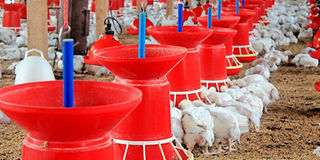Diary of a poultry farmer: Diarrhoea in birds and the likely causes

Broiler chickens feeding. Adhering to strict biosecurity measures is one of the surest ways to keep infections at bay. FILE PHOTO | NMG
What you need to know:
- High protein diets or damage to the kidney could cause watery diarrhoea in chickens.
- In severe infection with coccidiosis, the bird bleeds into its gut causing blood in the bird’s droppings and anaemia leading to a pale comb and wattles.
- There are over 60 other diseases that birds and their droppings can carry and the netting on the wire mesh is not enough to keep wild birds at bay.
The other day I received a text message from Emmanuel, my worker. “I’ve found 10 chicks dead as I opened the coop.”
A few days before, I’d transferred a batch of 170 chicks from the brooder box into an open barn. I was concerned about the cold at night, although at four weeks, they don’t require additional supplemental heat.
I’d also told the worker to put them back in the brooder box at night just in case, but without supplementing heat. I suspected the cause of death could be trampling and suffocation.
Upon further enquiry, he said that he’d noticed a few chicks were looking dull with twisted body as if to indicate they were feeling cold. I asked him to isolate them.
Later in the day, he texted to inform me that three more had died. He’d also observed loose droppings with streaks of blood.
Although I had an idea what I could’ve been dealing with, I still decided to contact a vet to confirm my suspicions. My experience is that it always helps to consult experts because sometimes they are able to identify problems faster and this minimises losses.
“You are most likely dealing with coccidiosis,” the vet said.
I’ve learnt how to use the colour of stool to make a diagnosis of diarrhoea in chickens. Coccidiosis is by far the commonest cause of severe diarrhoea and mortality in birds and it’s mostly characterised by blood or mucous in stool.
A greenish diarrhoea could indicate infection with a form of Newcastle disease that affects the gut, while a whitish pasty diarrhoea indicates infection with gumboro.
Yellow or green stool with pasting of vent feathers is most likely caused by fowl typhoid, while whitish diarrhoea is due to Salmonella pullorum, Dr Mugachia once informed me.
“When the droppings are firm and brownish with a ‘chalky’ white top, it’s considered normal. The white top is due to urates from the bird’s urine,” Dr Mugachia said.
STRICT BIOSECURITY MEASURES
Another thing is that besides bacteria and viruses, there are other causes of diarrhoea in birds such as incorrect diets and damage to the kidneys.
High protein diets or damage to the kidney could cause watery diarrhoea in chickens.
Now, to understand how better to control the coccidiosis parasite in my flock, I researched on its life cycle. The parasite lays thousands of eggs (oocysts) that are then eaten by the chickens. “If the birds ingest oocysts in large numbers, it damages the cells in the chickens’ gut resulting in loss of appetite, weight loss and diarrhoea”.
In severe infection with coccidiosis, the bird bleeds into its gut causing blood in the bird’s droppings and anaemia leading to a pale comb and wattles.
Another thing is that gut damage can also disrupt the natural balance of bacteria in the gut thereby allowing harmful bacteria to take over causing blood poisoning.
Thus, in addition to anti-coccidial medication, the vet prescribed an antibiotic to control the secondary bacterial infection.
He then advised that I also use multivitamins and a probiotic to restore gut flora. I wouldn’t have known all that if I’d simply walked into an agrovet shop and bought the medicines.
I’ve also tried to adhere to strict biosecurity measures which is one of the surest ways to keep infections at bay.
However, one challenge I still face on my farm is the swarm of wild birds that frequent the chicken pen for water and food.
There are over 60 other diseases that birds and their droppings can carry and the netting on the wire mesh is not enough to keep wild birds at bay.





